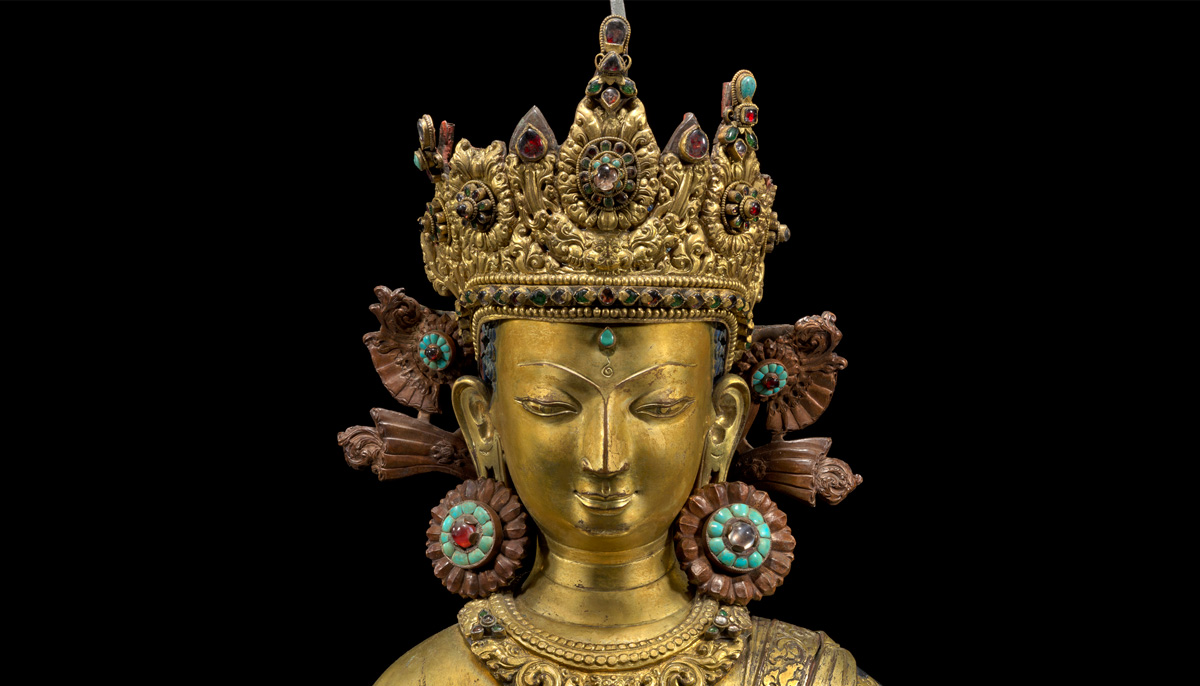In October, the Norton Simon Museum in Pasadena, California opened Benevolent Beings: Buddhas and Bodhisattvas from South and Southeast Asia, an exhibition exploring representations of protective deities used for blessings, guidance, and security. Through 44 artworks drawn solely from the museum’s extensive collections — many of them on view for the very first time — the exhibition examines the original contexts and uses of these works, including palm leaf manuscripts, stone and bronze sculptures of bodhisattvas and gods, and highly ornate gilt bronze buddhas. The objects are organized in accordance with the general layout of a Buddhist temple from 13th- to 18th-century South Asia, where the innermost chambers were devoted to the most sacred works.
Benevolent Beings is on view at the Norton Simon Museum through February 19, 2024. The museum, named after art collector and industrialist Norton Simon (1907-1993), amassed thousands of artworks over a 30-year period, including an array of South and Southeast Asian art spanning two thousand years. Assistant Curator Lakshika Senarath Gamage, PhD created spaces to display these pieces that inspire both spiritual wonder and intellectual curiosity.

We toured Benevolent Beings with Dr. Gamage, appreciating how she evoked different moods through each gallery’s use of color, and how she positioned certain pieces together to illustrate Buddhist concepts.
Walking through the three galleries, we keenly felt the lived reality of these pieces—not as historical objects, but as active elements of religious practice. For example, one 14th century bronze Sridevi statue from Tamil Nadu is portable and was carried outside in processions. Dr. Gamage explained that when religious objects like this are displayed in museums, such insight into their practical uses is lost.
The first gallery, “Seeking Protection and Making Merit,” painted in bright mustard, contains sacred objects used in complex devotional practices, such as a bronze incense holder from 18th century Tamil Nadu or Kerala, a 1st century BCE terracotta goddess figure from Kausambi (modern day Uttar Pradesh), and a Burmese palm manuscript (c. 1800).

The second gallery, “Seeking Tranquility,” painted a muted sky blue, contains depictions of bodhisattvas and Buddhas past, present, and future, such as a sculpture of Dipankara Buddha from Nepal (c. 1600-1650) made from copper and semiprecious stone and pigments; a watercolor on cotton Tibetan painting of Maitreya (c. 1800), and four figures depicting Avalokiteshvara in metals and stone ranging from 8th century Sri Lanka to 16th century Tibet. Most strikingly, the center of the gallery contains a fabric bodhi tree installation, under which sits meditating buddha statues. Dr. Gamage designed the installation so that viewing each of the statues requires visitors to circumambulate the tree, just as devotees in South Asian temple spaces have done for thousands of years.
The final room, “A Mindful Pause,” painted a muted dark gray, only contains one piece: a dolomite statue of a meditating Buddha from 5th-6th century Sri Lanka. Two benches face the piece, allowing visitors to experience the statue in stillness as they sit, reflect, or meditate. Though the statue is static, the dolomite stone flickers in the room’s light, reflecting the exhibition’s focus on Buddhism as an alive and lived tradition: never static and ever-changing.

Refreshingly, the objects displayed are not pristine, providing materiality to pieces considered holy and ethereal. A block printed cotton wall hanging depicting Nepali stupas (c. 1800) is visibly oil-stained and frayed, while fine details of some stone pieces are worn and faded, and even the featured final statue of the seated Buddha in meditation is missing its nose. In doing so, Dr. Gamage says, “We let the public experience all these objects in their imperfection.”
Bridging the sacred and the everyday practices of lived religion, Benevolent Beings allows visitors to imagine how real people, past and present, engage with divinity. Who were these artisans spending countless hours, days, and months molding stone into protective deities? Who were these monks painstakingly etching holy words into palm leaves? We may never know, but their work lives on. Bringing the heavenly down to earth, Benevolent Beings makes these seemingly untouchable deities tangible, and in turn makes the enlightenment promised by the Buddhist path seem achievable and within humanity’s grasp.

